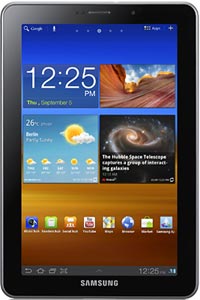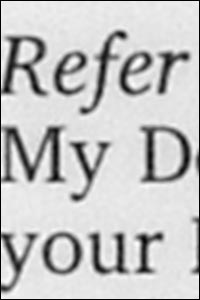All about Sony PRS-T1 and Sony PRS-T2 Electronic Books and more
t1-reader.cipds.ru
The screens of electronic books. Which is better?
 Inter-pixel grid
Inter-pixel grid
on the TFT display
Sometimes one can hear that the e-book reader screens that based on electronic ink (e-ink) are better, safer for the view than the color liquid crystal displays (TFT), because they glow, and the the e-ink reflects light, as is in the case of the paper in a conventional printed book. But why is the reflected light is better for the eyes - no one can explain. Let's deal.
The fact of the screen glow is not at all harmful to the eyes. The brightness of the display can always be adjusted so as it will be virtually impossible to distinguish the image on the screen from the screen with a reflective surface image. Screens that emit light, have a right to exist, and they may well be put into electronic devices for reading. But the "luminosity" - is not the only feature of the display. There are several factors that affect visual perception and eye fatigue. The color light-emitting displays are not the same. Let's consider the types of screens in terms of impact on our eyes.
The most common type of color screen is a LCD TFT with active matrix. It is typical for them the presence of "grid", i.e. spacing between the elements forming the image (the intervals between pixels are necessary to carry out the electrical connections between the active elements of the matrix). The higher the quality of the screen and the higher the resolution, the less visible "grid" when reading the text. For a screen size of 6-7 inches the screen resolution should not be less than 1024x768 pixels. Not only the grid factor, the panel production technology is also important. The most common technologies are TN, MVA/PVA, and IPS. Screens made by TN technology are the most inexpensive. But to read the text on these screens is uncomfortable. The fact that e-books with such screens have a small range of brightness and contrast, and the maximum values of these parameters are low. You cannot read a book on TN screen on a sunny day even in the shade. In addition, the brightness and contrast varies much depending on the viewing angle. The user tilting the book while reading experiences discomfort: the letters from the black become gray, and the effect is observed irregularly over the area of the screen. An example of an e-book with a TN screen (having a low resolution by the way) is Digma A700. The only advantage of these types of readers - the low price.
 Huawei MediaPad,
Huawei MediaPad,
IPS display panel
Models with LCD TFT panels, made on technology MVA/PVA and IPS, are without drawbacks typical to models with a TN matrix. They have generally higher resolution (and less noticeable "grid"), much extended range of brightness and contrast (one can comfortably read in bright rooms) and very wide viewing angles (up to 178 degrees) at which the brightness and contrast image does not change. Devices with the such screen are more expensive. An example of such a device is Huawei MediaPad.
There are also devices with color screens, made by the OLED or new AmoLED technology. In these screens, the image is formed by the matrix organic light-emitting diodes, and all electrical connections are made in the lower layer. The "grid" effect in these displays is missing. The OLED/AmoLED technology is more power-saving than TFT displays. Such screens have a huge range of brightness and contrast, and the best possible viewing angles. You can read from this screen even in direct sunlight (although it's hard, but in the shade - quite comfortable). A main disadvantage of e-books with such screens is a very high cost. For example, a great reader (tablet) Samsung Galaxy Tab 7.7 P6800 64Gb costs Moscow more than a thousand dollars at a moment of writing this article.
 Samsung Galaxy Tab 7.7,
Samsung Galaxy Tab 7.7,
Super AmoLED display panel
As the e-books, equipped with screens on electronic ink, then they are characterized by complete absence of "grid", the highest possible viewing angles (that are limited only to a frame around the screen). One can read a text at any bright light (it is possible and very desirable to use the
external lighting in a dark room, for example, at night in the long distance trains). It should be noted that there are several types of e-ink displays. The most common are e-ink Pearl and e-ink Vizplex. Screens made with Vizplex technology, are noticeably darker, have less contrast and less performance compared to the Pearl. All modern electronic books from well-known manufacturers have e-ink Pearl screens. The main advantage of electronic ink screens is a power saving feature: the battery is spent only on the turning of pages. At the same time there are some disadvantages of e-ink screens. 1. Low speed (screen image updating takes about 0.5 seconds - a color-emitting displays updates an image in approximately 0.01 seconds, which even allows you to watch movies on them). 2. Very low contrast range, an order of magnitude less than that of TFT-TN, about a hundred times less than that of MVA/PVA/IPS, and a thousand times less than the screen made of matrix organic light-emitting diodes technology. 3. The screens on electronic ink are black and white (although the sales has already started to appear on the device displays color e-ink, for example,
Ectaco JetBook Color, as long as they are very expensive and have not very good quality). There is a lot of good examples of devices on the e-ink:
Sony PRS-T1,
PocketBook 622 Touch,
Barnes & Noble Nook Simple Touch,
Digma S605, etc.
The basic types of screens showing the main features that affect the readability of electronic text and eye fatigue are given below.
TFT - TN. A noticeable inter-pixel "grid" in a low-resolution screens, a small range of brightness and contrast - the screen "fades" in the street, even in cloudy weather. Low angles, the picture changes significantly when one changes the view angle when reading e-books. Speed of the screen update is about 100 updates per second. With daily reading for two hours a day, the battery typically lasts for 2-3 days. The price of such devices is small.
 E-ink display, the inter-pixel
E-ink display, the inter-pixel
grid is not present
TFT - MVA/PVA/IPS. Inter-pixel "grid" is less visible because screens for electronic books and tablets of this technology are more typical with a resolution of 1024x768 or higher. Brightness and contrast of the screen are higher than TN, but still does not allow you to read on a sunny day even in the shade. Screen update speed is about 100 updates per second, you can watch movies. The viewing angles are rather high, the book image is not changing at any reading position. Screens made of this technology are usually put in more "advanced" device, with a well designed circuitry and a high capacity battery, so while daily reading for two hours a day, the battery typically lasts for 3-5 days. The price of such devices is much higher than the previous ones.
OLED and AmoLED. Inter-pixel "grid" is totally not present. The range of brightness and contrast is very high, the brightness can be adjusted so as to be able to read comfortably on a sunny day in the shade. Screen update speed is about 100 updates per second, you can watch movies. Viewing angles are very high, the book image is not changing at any tilted position. OLED and AmoLED displays much more power saving. For daily reading for two hours a day, the battery lasts for 5-10 days. The price of such devices is high, the most "advanced" costs more than a thousand dollars.
E-ink. Inter-pixel "grid" is not present. Contrast is very small, about two orders of magnitude smaller than the displays mentioned above. Nevertheless it is comfortable to read in normal light conditions (one can use the
external lighting in a low light conditions). It is much unpleasant to watch the gray-scale images (drawings, photos) on this screen. The screen update speed is about 2 frames per second, making impossible to view any videos, as well as to scroll text and menu. Viewing angles are very high, book image is not changing at any reading position. E-ink displays has the most power efficiency: the daily reading for two hours a day, the battery usually lasts for 30 days. The price of such devices is below the average (depending on the features and the manufactory name, and may be in the rage from 150 to 300 dollars for a device with a screen size of 6 inches). Devices equipped with a screen e-ink, as a rule, are smaller and lighter (with the same screen size), as compared to devices on the light emitting displays. The image on the most of e-ink screens is black and white. All the modern e-ink devices for electronic reading, that are produced by known brands, made with the Pearl display technology.
Gavriil Chitalkin, 2012/05/08
Notice: Use of undefined constant yday - assumed 'yday' in
/home/cipds/t1-reader.ru/docs/en/inc/voprosy_form.php on line
26
 Reference. Tips & Tricks.
Reference. Tips & Tricks.


